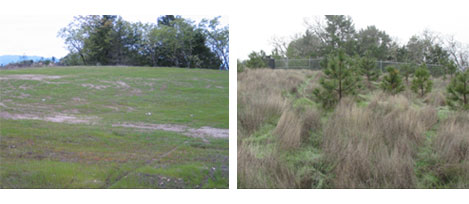ROADSIDE REVEGETATION
An Integrated Approach to Establishing Native Plants and Pollinator Habitat
Learn
Compost Amended Granitic Soils
| Location: | Landfill, Merlin Landfill Road, Merlin OR |
| Lat/Long: | N42o29'35.88", W123o24'0.9" |
| Dates Implemented: | April 2004 |
| Client: | Western Federal Lands Highway Division |
| Planners: | R6 Restoration Services Team, Greg Carey |
| Contractors: | City of Grants Pass, Greg Carey |
| Case Number: | 0006 |
| Date Submitted: | December 2008 |
| Focus Area: | Compost, mulch, seedlings |
Background and Objectives
The area directly above the Merlin Landfill is a site where soil and rock were removed and used to cap the landfill. The resulting landscape of the "borrow" area was a five acre, sparsely vegetated slope composed of shallow, imported soil1 over a weathered granitic bedrock. The low infiltration rates of the shallow soils and granitic bedrock had lead to rills and gullies throughout the project area. The revegetation objectives for the "borrow" area, as stated by the city administrator of Grants Pass, were to improve the watershed conditions of the area and reestablish the native vegetation to that of the surrounding mixed conifer forest. The main limiting factors on this site were the shallow rooting depths, physical characteristics of granitic parent material, lack of nutrients, and hot dry summers. We decided that the approach to revegetation should be two pronged: 1) rip the weathered bedrock to increase rooting depth2 and 2) incorporate compost several feet deep to keep the soils "open" and supply a long-term source of nutrients. Ponderosa pine seedlings would be planted and mulched. We decided to install a small demonstration area (1.25 acres) to test the methods being proposed prior to initiating a full scale project. If these methods were successful, then these treatments would be applied to the remainder of the area.
Implementation
Compost3 was delivered in a belly dump truck from the JO-GROW composting plant located adjacent to the project site. It was spread unevenly at a target depth of 6 inches with the blade of a D8 tractor. Pulling two shanks, the tractor cross-ripped the weathered bedrock to a 3-foot depth. "Planting islands" were located 30 to 40 feet from each other and at each of these sites, a backhoe was used to evenly mix the compost with the shattered bedrock to a depth of 2 to 3 feet. At each of the planting pockets three different stocktypes of ponderosa pine from a locally collected seed source were planted: 1) 2-0 bareroot, 2) one-gallon "tall pot" containers, 3) 18" "long tubes". The planting islands were then covered with a compost to a depth of 3 to 4 inches for weed control. Because of the late planting date (mid-April), drip irrigation was installed to water the plants for the first summer.
Findings
The survival of the container stock (tall pots and long tubes) after the first growing season was greater than 85% whereas the bare root seedlings averaged 40% survival. First year height for the container stock approached 2 feet high. There were pockets of mortality due to the flatheaded borer larvae (Chrysobothris sp) which chewed through the stem of the seedling. Weeds covered the site by the end of the summer. The "mulch" that we applied to the planting islands actually was a very good seedbed for weed seeds. After 5 growing seasons, the demonstration area is satisfactorily stocked with ponderosa pine and there is minimal soil erosion. Tree height ranges from 4 to 7 feet high.
In subsequent years, the remainder of the "borrow" area was treated in a similar manner to the demonstration area however, seedling survival and growth were less impressive due to 1) less compost added, 2) compost not mixed in with a backhoe, 3) very high competition with grasses.
Figures
The photograph on the left shows the "borrow" site demonstration area just before treatment in 2004. Note the poor vegetative cover and bare soil exposure. The photo on the right shows the same site in 2008. The ponderosa pine seedlings were planted in clumps on planting islands and range from 4 to 7 feet in height.

Applicability
We had not worked with these treatments on granitic bedrock before so implementing this project in steps was a good approach. An important lesson we learned (or relearned again and again) was that weeds must be controlled. A mulch is not a mulch just because someone says it is. In this case the mulch we used was actually a great growing medium and good source for weeds. If a mulch is going to be applied, it should meet the characteristics of a quality mulch.
We also learned that what we thought was a worthless granitic bedrock was actually a source of material to make soil from - just till and add compost. We also recognized the importance of thoroughly mixing the compost into the soil using a backhoe or excavator; ripping tines on a tractor can shatter soil/rock but this is a poor method for mixing compost into the soil. This project also showed that the combination of tilling and incorporating compost greatly improves watershed conditions.
Related Links
Merlin Landfill Forest Restoration Test Plot Demonstration A Summary of Findings (2.64 MB PDF)
Technical Guide,
10.1.3.3 Organic Aggregate Mulch
Contact Information
David Steinfeld, USDA Forest Service; 541-552-2912, dsteinfeld@fs.fed.us
1After material was removed from the borrow area, a 4 inch layer of silt, collected from a sediment pond, was applied over the weathered bedrock
2It appeared that the bedrock was so weathered that tillage would break the bedrock into gravels and sand size particles
3A partially decomposed mix of residential yard material and sewage sludge high in coarse wood